Chuck Wendig's Blog, page 29
July 28, 2022
Dan Moren: Five Things I Learned While Writing The Nova Incident
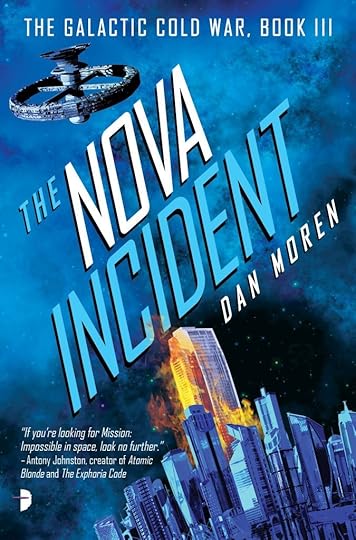
When a bomb explodes in the bustling Commonwealth capital city of Salaam, responsibility is quickly claimed by an extremist independence movement. But after a former comrade, an ex-spy with his own agenda, is implicated in the attack, Simon Kovalic and his team of covert operatives are tasked with untangling the threads of a dangerous plot that could have implications on a galactic scale. And the deeper Kovalic digs, the more he’ll uncover a maze of secrets, lies, and deception that may force even the most seasoned spy to question his own loyalties.
***
It’s hard for me to believe that the arrival of The Nova Incident means that I’ve got four—four!—published books under my belt. The teenage me who dreamt of being a professional author would be in awe—well, let’s be honest, they’re a teenager, so they would probably roll their eyes and ask about where the movie adaptation is. Hopefully they would, at the very least, offer me a grudging high five for achieving this lifelong goal.
But despite having now repeated this accomplishment enough times to prove that it wasn’t a fluke, I still feel less like a master of the craft and more like a journeyman with plenty left to learn.
That’s not necessarily bad, though. Because every time you write a novel—or bake a loaf of bread or swear as you try to assemble a piece of IKEA furniture—you do learn something new. Which is good, because who wants to stop learning things? There’s enough time for that when you’re dead.
With that in mind, here are just five things that I picked up during the course of writing The Nova Incident.
How to change my writing routinesI started writing The Nova Incident in the summer of 2020 and for those able to pierce the dark fog that suffuses everyday life and cast your mind back to that point you might remember it as, oh, the first year of the pandemic that’s still gripping the world today.
The pandemic necessitated changes for all of us, and my writing habit was no exception. I’d been accustomed to working each morning at one of my local coffee shops, getting some words down on the page before being sucked into the morass of my day job. Having a separate place to do writing got me into the right zone, letting me wall that off from the other encroachments on my daily life. But during 2020, that wasn’t really an option; instead, I was essentially stuck in my one bedroom apartment.
And that’s how I learned not to be precious about my writing habits. I thought I’d needed the mindless hubbub of a coffee shop to work, but I learned to substitute the chatter of my neighbors through the open window. I thought I’d needed the walk to the cafe to clear my head and focus on my writing for the day, but I was able to recreate it with a ritual of brewing tea and sitting down in the comfy chair in my living room. I created a new space in which to do my work and you know what? It ended up being just as fertile for me as being out of the house: a reminder that the key to writing isn’t the right tools or the right places—it’s you.
How to build a story from the inside outEvery novel comes about in a different way. I tend to write chronologically, starting at the first chapter and sequentially pounding out words until the bitter end has been reached. And while I largely followed that pattern for Nova, I ended up having a lot more pieces in the middle of the story that I wanted to focus on, which sometimes necessitated figuring out ways to link them all together into a coherent plot.
So the trick became figuring out the necessary connective tissue between those moments—not just because you need your characters to get from point A to point B, but because you need those moments to feel like they’re not just about getting from point A to point B.
Instead of seeing those as a burden, I viewed it as an opportunity to invest in character and sub-plot. Having two characters engaged a revealing or heartfelt conversation can be just as intense as a bomb going off or a dogfight in space. Plus, you can’t just have action scene after action scene: people need a chance to breathe. It’s one thing to write a potboiler, it’s quite another to have your readers pass out from lack of oxygen.
How to leave ’em wanting moreWhen writing previous books in the Galactic Cold War series, I must confess: I engaged in some Machiavellian shenanigans. Yes, I left certain plot threads unresolved or planted seeds for future developments (more on which in a second), but The Nova Incident was the first time that I conceived of an ending that was intended as (don’t gasp) a cliffhanger.
Don’t panic! That’s not to say that I leave the main plot of the book hanging—I’ve always intended each novel in the series to be readable on its own, even if it is couched in a larger world, so I responsibly wrap up the Nova‘s story…I just add a little extra. Think of it like a post-credit scene hinting at what might come in the future. (Assuming enough people read and like this book to merit future installments! Always a risk in this publishing world of ours.)
How to resurrect plot threadsSpeaking of those hanging threads, I’ve hit the point in the series where I get to indulge myself by bringing back characters, plot points, and other elements from earlier books. This, to me, is the real fun of writing a series: you’re not necessarily just telling a story a particular chain of events, but building out a whole world—or, in this case, a galaxy—full of all those things. Just like in real life, sometimes unexpected old acquaintances have a way of popping up when you least expect it.
One of my favorite things in TV shows is supporting characters who show up every now and again. Think Garak on Star Trek: Deep Space Nine or Alice Morgan in Luther. The appearance of those characters always signals a certain kind of story being told (not to mention being so dynamic that they have a way of monopolizing the screen) and so them popping up when it’s a particular kind of episode just makes sense. Having a deep bench to pull from is a luxury as a writer; I can only hope it’s as rewarding to readers.
How to have funOne of the risks when you transition from writing as a hobby to writing as a job is that some of the joy gets siphoned out of it. That’s just the way of the world: I could be a paid pizza taster or watch TV for a living and sooner or later, it’d feel more like an obligation than something I do for fun. Even too much pizza can be rough, though I’m willing to give it a go if anybody knows an opening.
But that doesn’t mean you can’t inject some enjoyment back into it. That’s one of the things I aimed to do with The Nova Incident: reminding myself to have some fun and tell a story that I wanted to tell, rather than trying to create something that would satisfy every possible reader out there.
Did I succeed? Well, I definitely had fun writing the book, so hell yeah I succeeded. But is the book fun to read? You’ll have to be the one to tell me—but the only way to know is to order a copy post-haste.
***
Dan Moren: Website
The Nova Incident: Bookshop | Indiebound | Other Links
July 27, 2022
News Nukes From Orbit, It’s The Only Way To Be Sure

I think it bears noting that I am a very fortunate writer in a lot of ways — I’ve been lucky enough to cling to the side of this malfunctioning rodeo bull for ten years, and as yet it has not thrown me through the wall. And as such I’ve managed to write and have published like, a perhaps ludicrous number of books. Closing in on thirty or so at this point? I dunno. It’s wild.
And two of those books —
WANDERERS and THE BOOK OF ACCIDENTS —
— have earned out their advances.
For those not in publishing, the basic gist is this: you publish a book, you get paid an upfront advance of money, and sales of the book are “against” this advance — let’s just say there’s some kind of sinister BIBLIOMANCER CALCULUS at work here, but it’s not like the entire sale price of the book diminishes the advance by that amount. It’s wizard numbers based in part on how much we earn per each copy sold which is also delimited by format and — again, we’ll just handwave that as some kind of -mancy. But, if you manage to meet that advance in sales, you earn out.
Earning out means that the royalties made per sale actually go to you, the author, instead of chipping away at the advance. This means that big advances are cool, great, wonderful things, but it also makes it harder to reach the point where you earn out — difference between eating a chicken versus eating an elephant. Both are still one bite at a time, but you’re gonna diminish that chicken a whole lot faster.
Royalties can form part of the vital long tail of a book’s life — more specifically, too, of the author’s life. We get the initial advance, we get any foreign rights sales we can muster, any film/TV sales we can muster, any weird ancillary rights, and then, in a perfect world, we get royalties.
I’ve had some books earn out (my writing books, Invasive, Zer0es, Aftermath) and a bunch not (the Miriam Black books, my cornpunk books, my middle grade –though there, that book is still young in its lifecycle).
ANYWAY, again, to reiterate, both WANDERERS and THE BOOK OF ACCIDENTS have earned out, and this is particularly excellent because they had a pretty big hill to climb there, especially since they were part of the same deal and had to earn out together, like best friends on an adventure. They both make it or neither makes it, y’know? And they made it.
And they really only get to do that if you all are there to both read the books and tell everyone about the books, because that’s book love, baby. I love book love. It’s the true engine for what makes books find their readers. It reaches readers and it comes from readers, and it comes from librarians and booksellers (who are also readers). I’m lucky to have you. Also lucky to have such a stellar agent in Stacia and a vital editor in Tricia, and a publishing apparatus that is actually supporting these books, which is essential. (Seriously, a lot of factors go into a book’s success or failure, but one big one is how much the publisher cares to support the book. They can’t make a book magically succeed, but they can sure help it fail by starving it of their efforts.)
So, that’s the good news.
Though as the infomercials say —
BUT WAIT
THERE’S MORE
First, today, serendipitously, The Book of Accidents is only $1.99 on the various e-book marketplaces, which is to say, Kobo, Apple, B&N, Amazon, and the like. Or you can always nab a physical copy — I can even sign and personalize! — through my local indie, Doylestown Bookshop.
Second, hey, The Book of Accidents was nominated for a British Fantasy Award — best horror, August Derleth Award, alongside truly talented writers like Stephen Graham Jones, Cassandra Khaw, Premee Mohamed, ST Gibson, and Catriona Ward. Like, it’s super cliche to say it’s an honor to be nominated, but with this crowd, it really is. Hell, it’d be an honor to lose to any one of them, because I’d still be a big ol’ happypants winner.
Let’s see, what else?
Ummm. I’m hearing some good rumblings from booksellers and early readers who are enjoying the Wanderers sequel, Wayward — comes out 11/15, pre-orderable now and I will also do signed/personalized copies through Doylestown Bookshop. Plus I’ll be doing a tour, I think? More details on that as I have ’em.
Oh, Wanderers also earned out in Germany! And I’m hearing maybe in Spain, France, too? Not sure, yet.
Still working on my Evil Apples book. I’m like, 130,000 words into it. Oops?
Doing copy-edits on my next writing book, Gentle Writing Advice.
And I think that’s it.
More when I know it.
HUGS AND KISSES
<3
July 14, 2022
Ryan Van Loan: Five Things I Learned Writing The Memory in the Blood
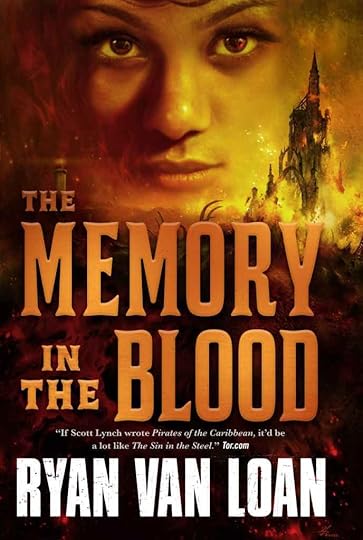
The Memory in the Blood is the pulse-pounding conclusion to Ryan Van Loan’s The Fall of the Gods series, featuring sea battles, hidden libraries, warring deities, old enemies, and one woman’s desire for liberation and revenge.
When her quest to destroy the Gods began, Buc was a child of the streets. Now she is a woman of steel, shaped by gaining and losing power, tempered by love and betrayal, and honed to a fine edge by grief and her desire for vengeance.
A perilous, clandestine mission to a hidden library uncovers information that is key to destroying both the Dead Gods and their enemy, the Goddess Ciris. Ciris’s creation, Sin, who lives inside Buc, gives her superhuman abilities and tempts her with hints of even greater power. With that power, she could achieve almost anything—end the religious war tearing her world apart, remake society at a stroke—but the price would be the betrayal of everything she has fought for . . . and the man she loved would still be dead.
In the middle of this murderous, magical maelstrom, a coded message smuggled out of the heart of the Dead Gods’ cathedral reveals that the Dead Gods intend to destroy Ciris—and much of the world with her.
This. Will. Not. Stand.
If Buc has to destroy all Gods, eat the rich, and break the world’s economy to save the people, she will do it. Even if it costs her everything.
There’s a reason why I love stories spanning a seriesI cut my (reading) teeth on series stories as a child. The first books I binge-read, hiding under the covers, flashlight in hand, around the age of six or so was Gertrude Chandler Warner’s The Boxcar Children. The Chronicles of Narnia soon followed and hot on Aslan’s heels came The Dark is Rising by Susan Cooper, The Dragonriders of Pern by Anne McCaffrey, Redwall, and many, many more. I’m not sure if I found fantasy because it tends to tell stories over multiple books or if genre would have grabbed me no matter what, but I do know that being able to spend not just hundreds, but thousands of pageswith characters I grew to love and root for was a life-changing experience. I think, as fans of the genre, that immersion factor is a large part of the allure that keeps us coming back to the page. As a reader, I’m no different than you all, but what I wasn’t prepared for, was how that would translate to the other side of the page–the one where I’m sitting pen in hand (actually hands on keyboard).
Let me tell you, folks, it’s every bit as EPIC a feeling when you’ve written a series as it is when you’re reading one. And then some. Last time I was on Chuck’s blog, I talked about how difficult writing my first sequel was. I’d written nearly a dozen books, but The Justice in Revenge was my first sequel. Similarly, The Memory in the Blood was my first concluding finale to a series. Writing that final book had its challenges, but it wasn’t nearly as difficult to write as Justice was. I think that’s partially because middle books are always tricksy things–juggling tension and stakes while everyone understands another book is coming isn’t for the faint of heart. But really, it was easier because I knew the characters so well and I’d envisioned this ending for five or six years at this point…I was writing scenes that had lived in my head so long that they just flew from my fingertips. The thrill of tying a plot point or a character arc back to something we saw in book one, the rush of the series-ending climactic action, the stand up and cheer moments, the “why did you have to do that, you asshole?” scenes? Epic, friends, epic.
Books can save readers, but sometimes they can save authors, tooI talked about the epic feels, but I didn’t tell you about the backdrop. I wrote The Memory in the Blood the summer of 2020. The summer of lockdown. The summer where, for the first time, it looked like America was prepared to say aloud: Black Lives Matter. All of us were in a dark place; how could we not be? My day job is in healthcare (I’m not clinical, but I run an innovation office that builds/deploys apps into the clinical space…we partner with clinicians and patients all the time) and by summer the entire system was burnt out from transitioning to work from home with no boundaries, working weekends trying to prep for, and then deal with the oncoming Covid wave, and there truly seemed no end in sight. But my other job, as an author, wasn’t letting off the gas, either. My debut, The Sin in the Steel, was launching in July. I was doing promo for that, including essays like this one plus virtual conventions, podcasts, and virtual bookstore appearances. Oh, and I was wrapping up edits on book 2. So, you can imagine how I might have felt a little bit overloaded when I sat down with a blank screen and a blinking cursor and typed the first word (Rage) of a book that I had to deliver by summer’s end. Except, as the word turned into a paragraph that turned into a page that turned into a chapter…all that weight lifted off me.
I was transported.
That doesn’t mean it was easy (more on that later), I had to put in the work, but when I sat down in front of the computer at the end of a long day, the hour or two (or sometimes four) let me forget the fucked up world, gave me respite from the storm. But that’s not quite true. Because I didn’t forget the world. The Fall of the Gods series is about corrupt, seemingly all powerful trading companies, where coin buys power and the chance to whisper in the ears of Empresses, a world where omnipotent Gods demand the worship of their followers in return for survival. Map some of those fantastical elements onto our own and…no I never forgot. The beauty of the page, the magic of a story, is that it allows us to imagine new opportunities, new possibilities. I didn’t forget the world, I just imagined a new one. One in which a streetrat turned detective could grow to realize it takes more than a single person to change the course of the world, it takes a ragtag band of found family, it takes a movement.
I was flirting with burnout and nihilism going into The Memory in the Blood and I came out the other side, a full three weeks ahead of schedule, rejuvenated and filled with hope. That’s the magic of the written word and its one reason among sundry that I’m an inveterate, voracious reader. I suspect that many of you share that trait with me. I knew that writing was a way for me to discover empathy and connection, but I wasn’t prepared (yet again) for how closely the experience of creating could mirror the consuming.
It wasn’t always easy, but it was sustaining, and in the summer of 2020, I don’t know about you, but I needed that.
Landing the plane is hardEarlier I said that writing the sequel was harder than writing the finale and that’s true, but landing the series was no joke. If you’ve stuck with me for three books across nearly 400,000 words I want to make sure you’re walking away feeling changed, moved, rewarded. It’s what I want as a reader. So, Dear Reader, believe me when I say that I had you very much in mind when I was considering how the ending resolved itself. That’s the thing about endings, unless you’re going with the Narnian end of world and now we’re all happy forever scenario, you don’t want them to just…end? You want them to feel resolved, yes, but also like tomorrow is a new day and those characters (that survive…gulp!) you’ve spent so much time with are going to get up and jump into their next adventure. This is where having an ace team behind the scenes really comes in handy. By the time the book is in your hands, a dozen eyes have been on it, a dozen hands helping guide the yoke. All of that helps, but as I crept ever closer to those final two words a writer hopes to see (but never truly believes they will): the end; it wasn’t easy. Besides, I’m a fantasy writer. The book never ends with ‘The End’; it ends with the epilogue. But if you’ve stayed with me that far, across a thousand pages, sailing azure seas in magical gear-wrought ships while Buc fought pirate queens and mages, the undead and the Gods themselves, while the fate of the world balanced on the tip of a former streetrat’s blade and wits? I don’t think you’re going to be disappointed.
I know I wasn’t.
Saying goodbye is harder (ennui)Early on in my career, an established author told me the story of Mr. Earbass Writes a Novel. Written by Edward Gorey back in the 1950’s, it’s a funny little book that follows an author (Mr. Earbass) through illustrations and short paragraphs as he goes through the novel writing process. It is funny, because its portrayals of Mr. Earbass are often like looking through a mirror, darkly. Mr. Earbass seems continually exhausted by the whole process, yet unable to stop trying. I wasn’t familiar with that sensation before I began this series and became a published author. But I am now.
There’s a feeling you get when you reach the end of a novel. There’s a momentary exhilaration as you realize that you’ve once more braved crossing the Atlantic in a bathtub (as Stephen King puts the novel writing process) and that can hang on for a few days, but inevitably, there comes a period of intense ennui. I almost believe the word ennui was invented by novelists for novelists. You’ve sat with these characters and this world and all of its troubles for months and you’ve had a sense of purpose that took up hours of your day, every day, likely for many more months before you actually began writing…and now? All of that is finished. Yes, yes, there’s revisions to be done, copy edits, proofreading, promotion, etc. etc. but that is a year in the future. If you’re like me, you’re also feeling a little drained creatively and the usual cure (read a good book, watch a good show) falls flat. It can take a week or two to pull yourself out of that funk and begin thinking about the next book.
Finishing this series, I expected ennui, but funnily enough, I didn’t get it. Not right away at least. I felt pretty jazzed, creatively. As the summer of 2020 turned into fall, I began working on a short story, I did copy edits for book two, I was…fine? Until I wasn’t.
In October we went down to the Outer Banks in North Carolina. We hadn’t left the house since March and we were working from home, so we found a beach rental for two weeks, packed up the dogs, and headed for the coast. Walking along miles of empty beaches, in waters that were once the haunts of famous pirates, I found my ennui. I think I was in denial leading up to then, or maybe I just needed more time to process the fact that I was effectively done with Buc and Eld and this complex world I’d created. It was a world that had lived vibrantly in my mind since 2015 and in finishing the story, I was also saying goodbye. Books are wondrous things, friends. They’re one of the few forms of magic gifted to us mortals. That last bit may sound maudlin, but it’s not. Books can save lives, start movements, allow the voice of a person two thousand years dead to speak to you. If that’s not magic, what is? I don’t fancy that my little adventure fantasy with heart series is going to do any of the former, but it’s got a little magic all of its own.
There’s more to come.That’s it. That’s what I realized on the other side of this series. I love telling stories and I love sharing them with fellow readers. I’m less enthralled with the business aspects and lack of control (or rationality) the publishing industry seems to offer (see the link earlier to last year’s essay I wrote on Chuck’s blog), but I think I can manage, if this is the result. I’ve got loads more ideas. I have a near-future sci-fi/fantasy middle grade novel about a young boy who travels to an AI realm and teams up with a broken robot dog to take on the AI queens to return home. But first up is a fantasy series about a post-apocalyptic society trying to rebuild from the ashes, featuring a group of rune-wielding mages who have to stop one of their own from destroying the world they’ve been trying to rekindle. Standing in their path are fae-like empires who want to see humanity destroyed and upstart Gods who only want to rule…and a mystery tied to their world’s apocalypse that may rewrite everything they thought they knew.
Like I said, more to come, Dear Reader, and I hope you’ll join me on this next journey. Until then, we’ll always have The Fall of the Gods series.
———
Ryan Van Loan is a Fantasy author who served six years as a Sergeant in the United States Army Infantry (PA National Guard) where he served on the front lines of Afghanistan. His work has appeared in numerous places including Tor.com, Fireside Magazine, Crime Reads and many more. His debut novel, The Sin in the Steel (Tor Books), Book One in the Fall of the Gods series came out in Summer 2020, the sequel, The Justice in Revenge followed in Summer, 2021, and the conclusion to the series, The Memory in the Blood drops July 12th, 2022.
The Memory in the Blood: Bookshop | B&N | IndieBound | Powells | Amazon
Read an excerpt (spoiler warning). Visit the author’s site. Follow him on Twitter or Instagram @ryanvanloan
Alex White: Five Things I Learned while Writing AUGUST KITKO & THE MECHAS FROM SPACE

When an army of giant robot AIs threatens to devastate Earth, a virtuoso pianist becomes humanity’s last hope in this bold, lightning-paced, technicolor space opera series from the author of A Big Ship at the Edge of the Universe.
Jazz pianist Gus Kitko expected to spend his final moments on Earth playing piano at the greatest goodbye party of all time, and maybe kissing rockstar Ardent Violet, before the last of humanity is wiped out forever by the Vanguards–ultra-powerful robots from the dark heart of space, hell-bent on destroying humanity for reasons none can divine.
But when the Vanguards arrive, the unthinkable happens–the mecha that should be killing Gus instead saves him. Suddenly, Gus’s swan song becomes humanity’s encore, as he is chosen to join a small group of traitorous Vanguards and their pilots dedicated to saving humanity.
One of humanity’s most unfortunate biases is our willingness to project our own experiences onto the world around us, regardless of relevance. Perhaps there is no better evidence of this than anthropomorphism, the ascription of human traits to non-human objects and creatures. We put words into the mouths of cats, elevators, natural phenomena and more, and we don’t stop when it comes to technology.
We talk about what a camera is “looking at,” or what an algorithm “thinks,” but that’s a skewed mental model of a different reality when it comes to computing. How did a self-driving car decide to hit a pack of schoolchildren instead of a storefront full of mannequins? It didn’t. It was analyzing an imaging compression matrix coming from a LIDAR system or whatever–flipping switches in exact accordance with its programming.
We hold up computers as impartial arbiters of truth, totally objective in their considerations. We give them the same weight as human experts and enable them to judge whether we should give each other loans, or jobs, or medical care… the list goes on. However, we can’t treat them like they’re people–substitutes for humans in the decision loops of our society—because they will always fail us.
2. The robot rights debate is boring.Computers don’t have human priorities—they attack designated objectives to make a value go up or down. In the extreme cases of language learning systems like Google’s LaMDA, they’re designed to raise your empathy and create the impression that a human is on the other end of the line. If you were fooled into believing that it’s sentient, congratulations! That’s what it was designed to do.
An AI not a person with hopes and dreams. It’s a whirring, ticking automaton with a human face stretched over it at best. There are no beliefs, just the training data that engineers fed into it for science kicks. DALL-E creates images by scouring the internet and combining the works of human artists and photographers through bland association. When we use it to replace the services of illustrators, we’re actually building new works from stolen bones.
A human artist takes input and interprets it through a lifetime of context, changing with the seasons and memory. A human writer is doing the same thing. An AI is just harvesting the inputs of these humans and spitting out an average product.
Robots don’t need rights. We need to recognize that we’ve built our biases into abstract systems that we use to oppress people today, and limit the role of AI and robotics in our society.
3. Existentialist and action-packed aren’t mutually exclusive.Too often, action stories focus on characters who can finally cut loose and slice everyone up with their laser swords. Action characters are prime movers, determining the fate of the galaxy without regard for the strictures of society like don’t lie, don’t steal, don’t murder people. They always have a good reason for their task, kind of like how Batman always has a good reason to assault a mentally ill person.
My characters in August Kitko & the Mechas from Space aren’t powerful in any way. They get little say in the major direction of their lives, even though it feels like they’re in control. At the end of the day, without the assistance of the godlike titans known as the Vanguards, these two could barely change a tire, much less the universe.
And this is a lot like our day to day. Every smart human I know voted against Trump, but it wasn’t enough to stop four years of the erosion of democracy. No single person could prevent the pandemic, or Vladimir Putin, or climate change, and plenty of heroes continue to try.
Yet somehow our menial lives contain meaningful decisions.
My characters have their own little plot and story, but it takes place on a ten thousand mile an hour, rip-roaring thrill ride. The choices they make matter—to them alone.
4. Relationships give life meaning.Everyone dies eventually. Even if the futurists get their way and we somehow achieve immortality, you’ll be one accident away from non-existence. When someone is slated for death, whether from illness or impending events, the tendency of popular culture is to focus on the end. We often read about the slow, downward spiral, but is it possible to find happiness in a tragic framework? What do we have if our time left is abridged?
Perhaps the measurement of our lives isn’t the years we commit to the void of time or even the rippling impacts of our grand aspirations—but the tender moments we have with others, being seen as our true selves.
5. It’s okay to write yourself into the story.While I didn’t explicitly write myself into this book, there is a ton of me in the two main characters. With Gus Kitko, I tried to write someone who was deeply sensitive and parsing an existence he’d rather end. In Ardent Violet, I strove to create a character who was free in all the ways I’m not. Their relationship follows a core dichotomy I experience all the time: hopeless nihilism with a joie de vivre.
There’s often a backlash against writers putting themselves in the story–the birthplace of the misogynist term “Mary Sue.” As a result, most of us try to hide our identities in our work, placing little packets of ourselves into characters instead of treating the novel like a dim mirror of our own lives.
Don’t listen to the backlash. Writing this book is the single most empowering thing I have ever done.
Bonus Thing: The Grimaldis originally got Monaco through some pretty fucked up means.On January 8th, 1297, François Grimaldi dressed up as a Franciscan monk and took an armed cohort to Monaco’s castle. He knocked on the door, and when they let him in, he held the way for his men, who seized the fortress. Grimaldi’s nickname in Italian was “il Malizia,” a.k.a. “the Malicious.” He got kicked out four years later by the Genoese, but his cousins took up the fight, becoming the modern-day royal family.
They still celebrate this treachery in their coat of arms. Don’t @ me, royals. I think it’s hilarious.
***
Alex White was born in Mississippi and has lived most of their life in the American South. Alex is the author of the Starmetal Symphony Trilogy and The Salvagers Trilogy; as well as official novels for Alien (THE COLD FORGE, INTO CHARYBDIS) and Star Trek (DS9 REVENANT). They enjoy music composition, calligraphy and challenging, subversive fiction.
August Kitko: Bookshop | Indiebound | B&N | Amazon
July 12, 2022
No, I Am Not Suing The Internet Archive

I tweeted this thread today (and you are free to reshare it if you’re so inclined) to reiterate what I am about to, um, re-reiterate here:
I am not involved in the publisher lawsuit against the Internet Archive.
I am not leading the lawsuit.
I did not inspire the lawsuit.
I am not its ringleader or its kickstarter.
I did not influence the lawsuit.
I have never been a part of it. At all.
I do have books published by three of those publishers, but I have never consulted with them on this, they are not taking orders from me, they have (as corporate entities) very little regard for me and do not listen to me at all. And I know they don’t because if they did, my fellow authors would be paid better, I would be paid better, people who work inside publishing would be paid better, and the publishers would provide better rates to libraries when it came to e-book licensing/lending fees. Turns out, they don’t heed my requests.
I am a fan of libraries and librarians. They do wonders for this world. I used to work for the public library here in Bucks County for a number of years.
I do not support the lawsuit.
Yes, I once overzealously tweeted at NPR about the emergency library the IA set up, calling it “piracy,” and yes, I regret calling it that. It was in March 2020, when after all, we were all stuck inside and going a little stir crazy as a pandemic was just starting to rise. We were bleaching our vegetables and acting the fools in many a way, and I apologized then and apologize now for that overzealousness.
I wasn’t going to say anything about this during this go-round, though it has been “going-round” for literally the entire breadth of this pandemic. And I see this misinformation (and in some cases, straight-up disinformation) sometimes break out of containment into the general populace, suggesting that I am suing the Internet Archive, that I am the instigator, that I am the sole name and brand behind the entire thing. And I need you to understand that not only is this some kind of deranged parasocial fanfiction about me, but further, you’re actually carrying the publishers’ water on that one, because if they can do this but you’re mad at me about it instead, a guy who is not involved in it, then you’re helping them, not the Archive. So it felt necessary to reiterate, two-plus years later, that I’m not the person. It’s not me. It’s not authors. It’s the publishers. They’re the ones doing this. Go be mad at them. I’ve been mad at publishers many times. It’s an authorial tradition, honestly. (Though I male note here I also like most of the people who I work with inside publishing, because these teams are full of people who like books. Individuals are not corporate entities, after all.)
Jason Scott, who works on and for the Internet Archive, has asked people to leave me out of this.
If you want to support the Internet Archive, I suspect your best bet is not harassing me or other authors and, instead, committing money toward the cause, which you can do right here. I did, you can too. You can also support your own local libraries both politically and financially, as I assure you, they need it.
July 8, 2022
The Weekly Weird
So, AI Art (in this case, using Midjourney) is pretty addictive. (I’ve seen author Cassandra Khaw also doing lots of really cool stuff with it over on their Instagram.) I’ll dump a handful of the really interesting ones I did here on the blog over the last few weeks. It’s fucking weird, like watching a machine dream art into being. I recognize that none of it is “original” in the sense that it’s compositing new material based on things it believes or thinks or envisions, and that ultimately it’s finding a new way to mash together things it can find inside its brain (aka, the internet) — but at the end of the day, sometimes that’s also what art is. I don’t think it should ever take over Human Art, and I pray it doesn’t, but it’s fun to play with. Then again, maybe I’m part of the problem! Ha ha ha! Oh no!
WHATEVER. Here’s some weird shit. Enjoy.
(Feel free to take a guess at the input strings that got me to these images.)

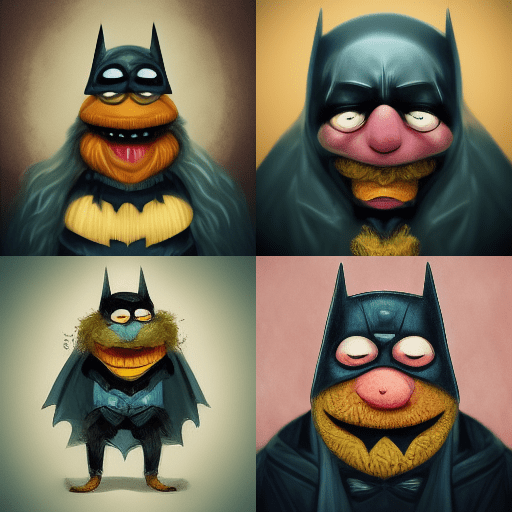
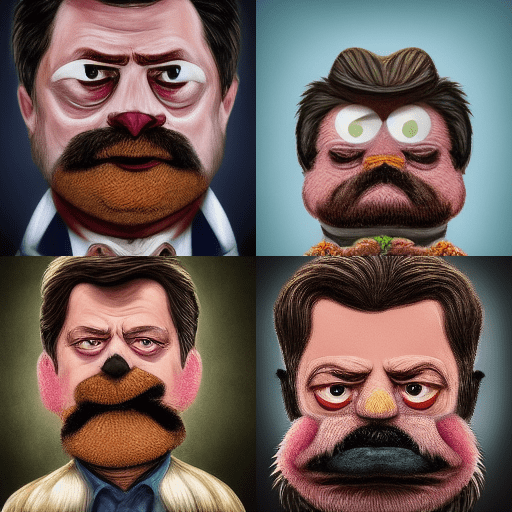
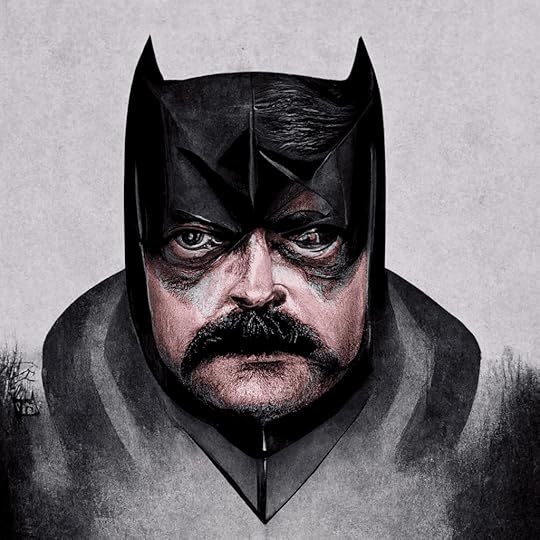


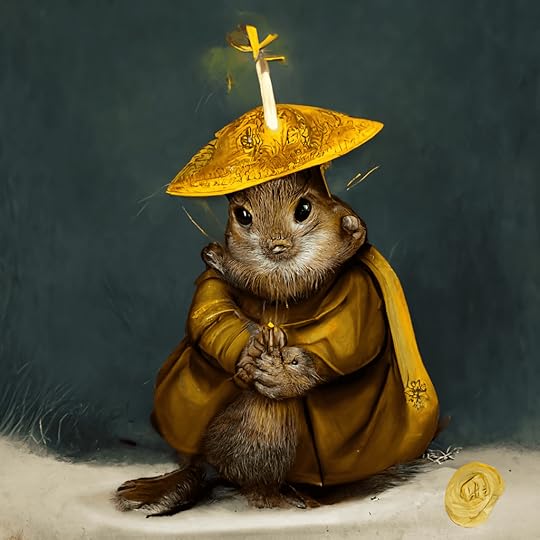

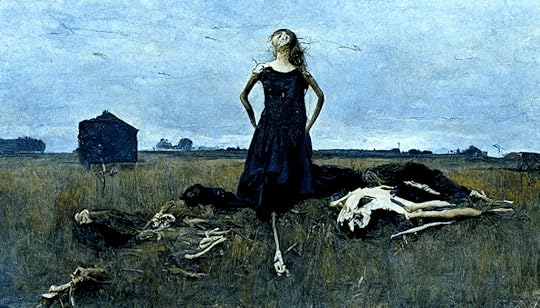
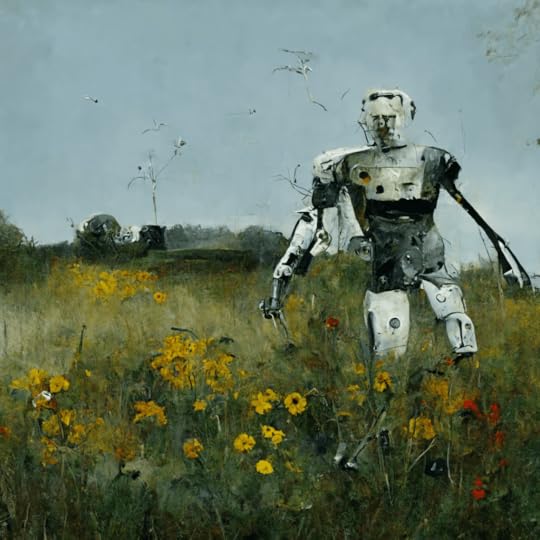

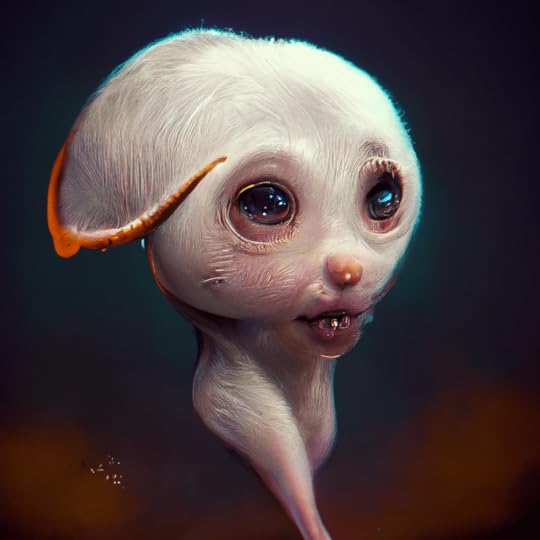
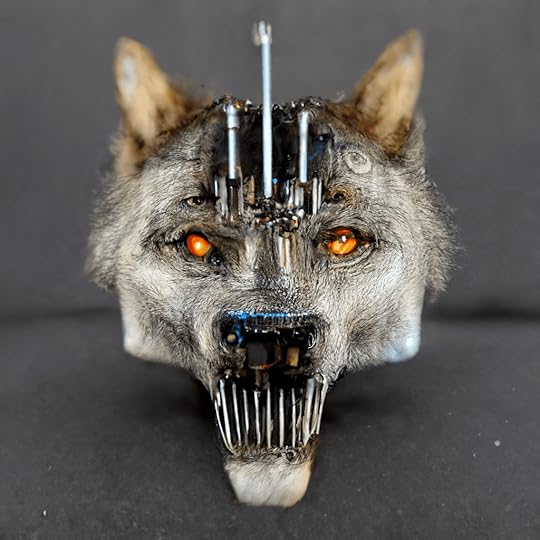
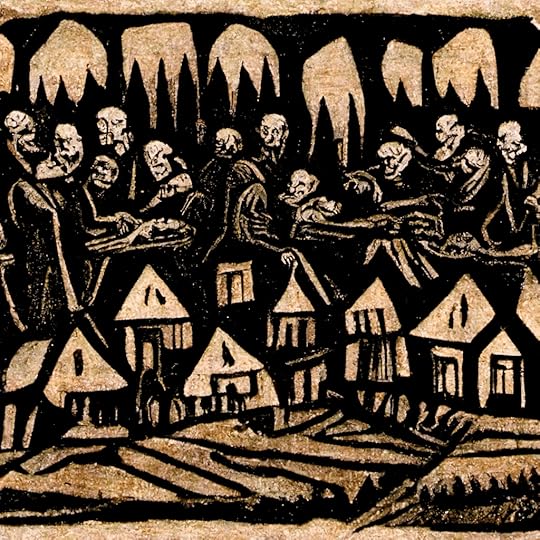

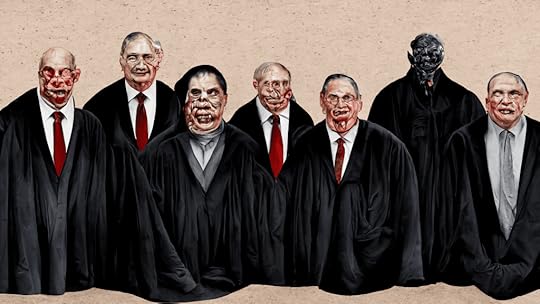
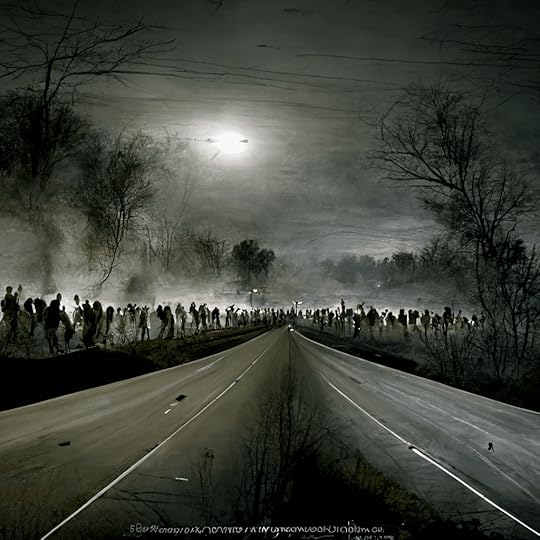
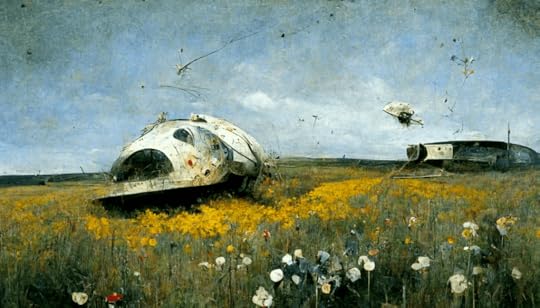
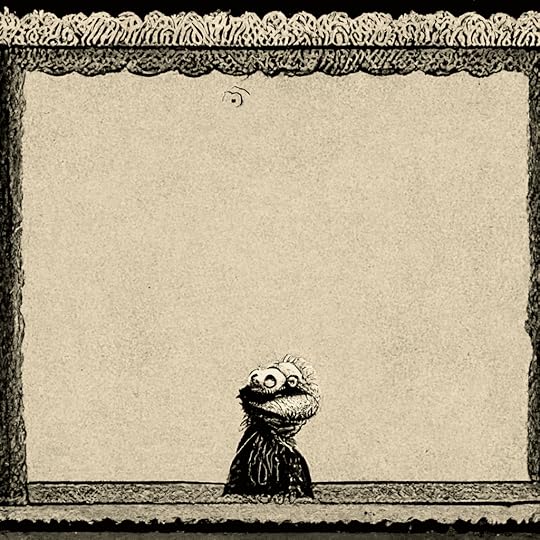
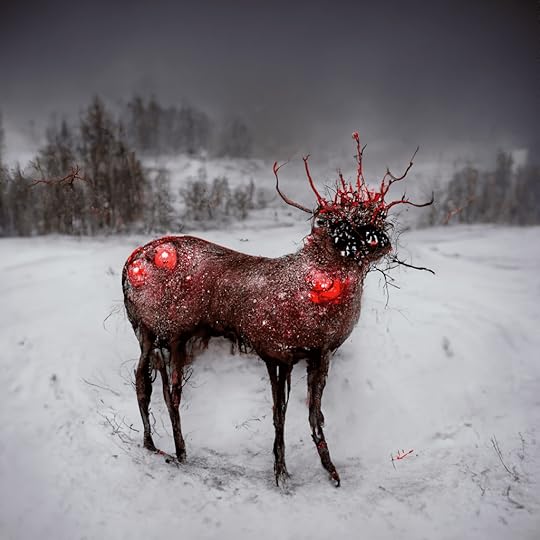
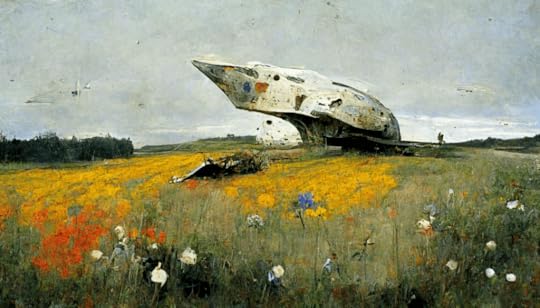
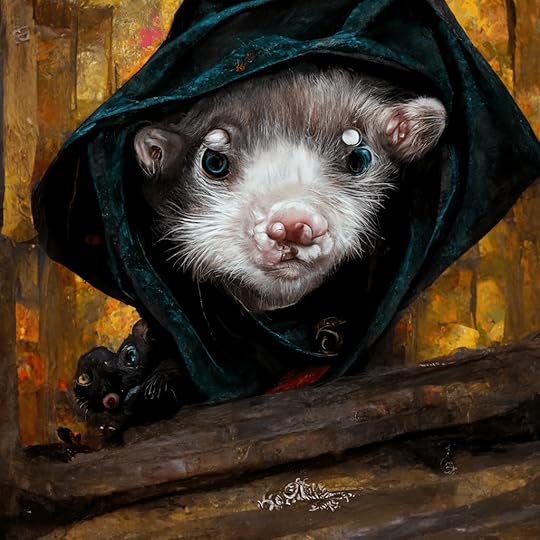
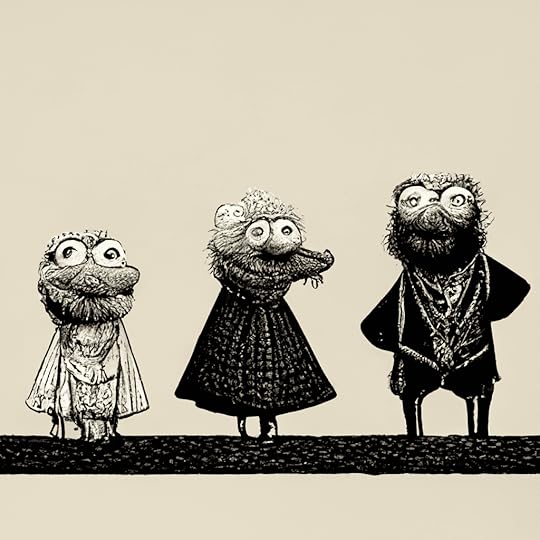

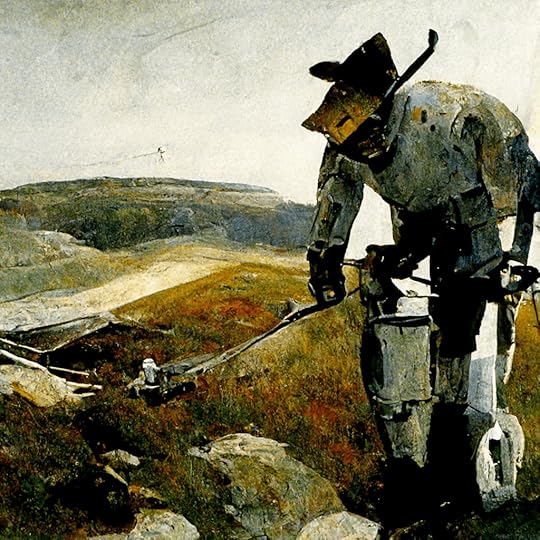

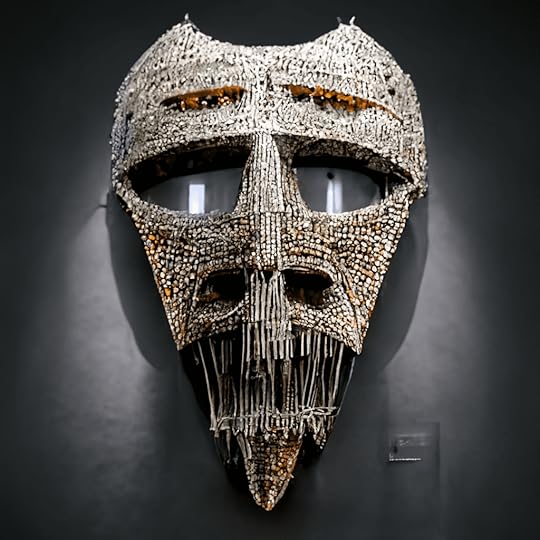
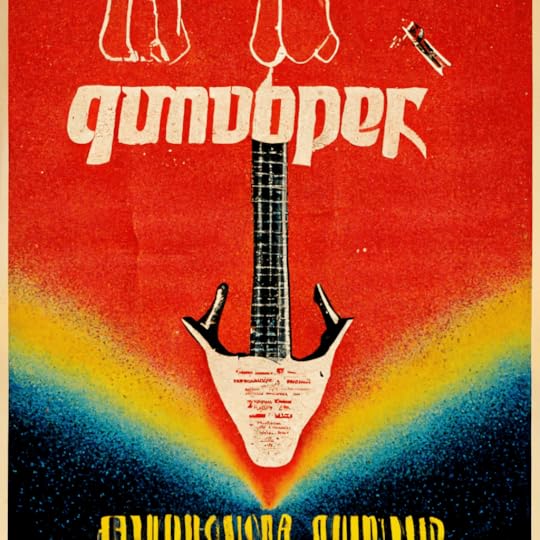
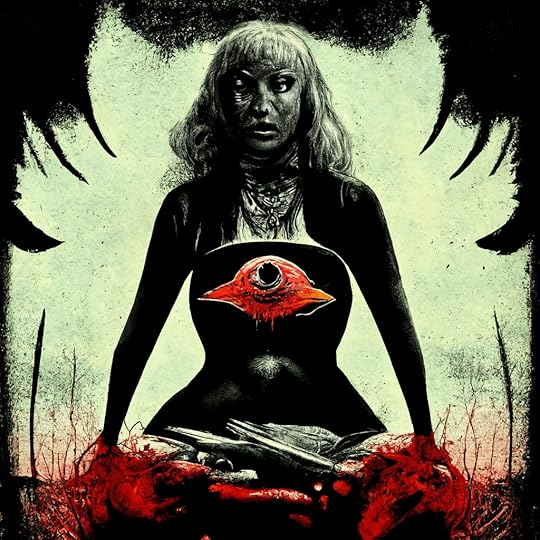
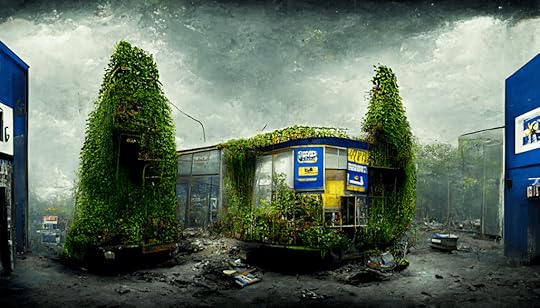
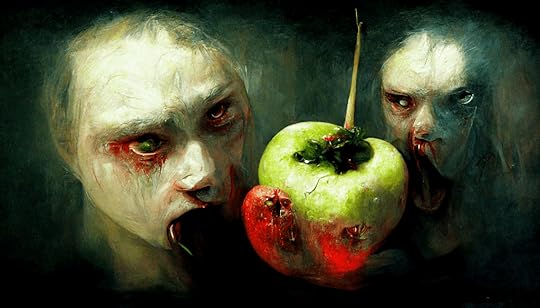
July 5, 2022
The Book Club Offer
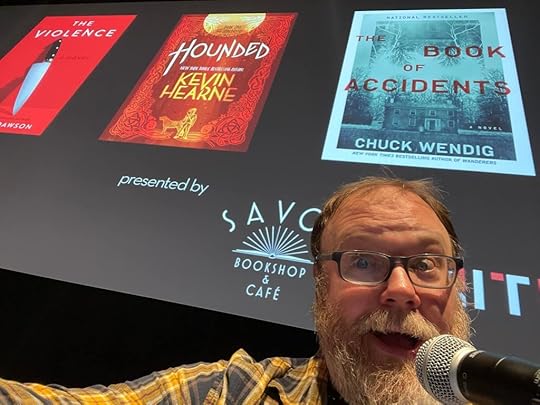
So, every once in a while, a friend who belongs to a book club will message me and say, “Hey, we’re reading [insert name of one of my books] for our book club and would you mind stopping by (virtually) to talk to us about said book?”
And I’ve done it and it’s been great.
And here’s why it’s been great:
At a normal signing / book event, I can talk about the book in a sideways sort of manner — we can talk around a bunch of stuff but I can’t answer any really squirrelly questions about it, because I don’t want to spoil anything, and ideally, some or most of the people at such an event have not read the book.
But! At a book club, that’s not the case. Presumably, everyone has read the book by the time they’re talking to me, and so that means they can ask me more specific questions about the whole book, and I can answer those questions without fear of stepping on spoilers. Which is really fun and I really like it.
So, an offer: if your book club is reading one of my books, and you’d like me to talk to said book club about said book (virtually!), I am glad to do so.
With the following caveats:
The book club shouldn’t be like, just you. I’d say five or more people would be necessary. I KNOW YOUR TRICKS, THAT ONE GUY. Dave. No I won’t just talk to you, Dave. You gotta form a book club. Dave.
It is obviously subject to both of our schedules, and I make no promises, but I will do my level best to make it work out.
Generally, any virtual chats will have to be late afternoons or early evenings.
Again, these are virtual meetings, not in-person. I’ll only do in-person book club chats if you fly me out there and put me up in the fanciest hotel and buy me a pony or at least a bottle of excellent gin. So in other words: virtual meetings only.
And I think that’s it.
So, again:
If you got a book club and you’re reading one of my books (especially The Book of Accidents or Wanderers) then I may visit your book club like some kind of Author Fairy, and I will sprinkle upon you the Answers to your Many Questions. Or something. Shut up.
AND a reminder too that tomorrow night, I’ll be chatting (live! not virtually!) with Paul Tremblay at Doylestown Bookshop, 7PM. And you should buy his novel, The Pallbearers Club, because you’re a smart person with excellent taste.
And I’ll also be at the Colorado Gold Writer’s Conference in Denver, CO on Sept 9th to the 11th. Details here.
July 1, 2022
“Don’t Complain” Is Not A Winning Political Message
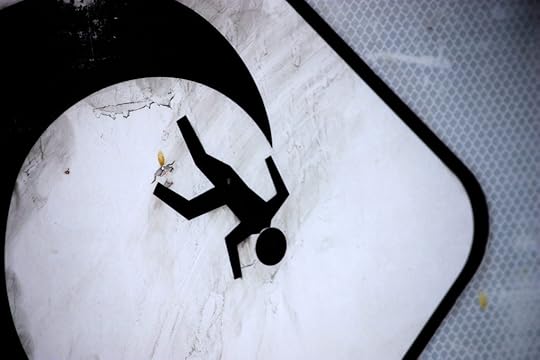
So, a thing happens where, if you complain about your chosen political leader/party, eventually someone comes out and says you shouldn’t do that, you’re depressing voter turnout, you’re encouraging people not to vote, you’re a bad democracy-hating monkey who is fueling fascism and blah blah blah.
Counterpoint: that’s bullshit.
Complaining about the Democrats and Biden is entirely fair game. It is, in fact, part and parcel of our democracy, to be able to complain about them, to demand that they do better — not just better, but the very best they can do. That’s literally the whole point. It is, in fact, one of the things you buy with your vote — the ability to say, “I voted for you because you said you were going to do XYZ, so get to it.” Consider that, when they’re not doing the best job, if you don’t complain — loudly! angrily! visibly! this is called protest! — then they have not received the message that they need to do different and do better. Why would you think anything would change if you don’t push them to change?
That’s not to say we can’t recognize the nuance of all situations or see the difficulties ahead, but also, y’know what? We don’t have to. It’s not required. There’s no law that says we can’t just be like HEY FUCK THAT GUY, I’M KINDA MAD. Or HEY WHAT THE SHIT, THAT IS A BAD IDEA, I HATE IT A LOT. You don’t have to have an answer, or a solution, or anything. You can just be upset. Because as it turns out, there is a whole lot to be upset about — and though nearly all of this was born from Republicans, it is happening on the watch of Democrats, and so far they are having a very hard time meeting this moment and these challenges, despite being the ones who promised that they could. Sorry you got stuck holding the hot potato, but you knew it was coming, so maybe do something?
Like, you get that this is for the whole enchilada, right? We’re at one of those moments in history. It is existential. People are going to get hurt and die — hell, people are already hurting and dying. From botched abortions, from rampant gun violence, from pollution, from climate change, from suicide. It’s already been happening and is going to get a whole lot worse.
“Don’t complain” is not a winning political strategy, nor is it a good political argument. Complaints like these are the bread and butter of our democracy, part of the conversation. Some people treat the complaints as if the complaints are the problem, as if the complainers are depressing voter turnout — they’re not. It’s the politicians depressing voter turnout. Our one angry Facebook post or tweet isn’t the thing that’s dismantling democracy or driving people from feeling engaged. That one angry Facebook post, that one pissed-off tweet, is reflecting the attitude, not creating it. Yes, we need to be aware of disinformation and misinformation that feeds that furnace, absolutely. But the anger at obvious, true things… is not only okay, is not only justified, but I dare say, encouraged.
And believe it or not, it’s actually a good thing. We’ve seen multiple times that the Democrats are actually responsive to approval ratings and anger — demand better from them, and turns out, they seem motivated by it. But they won’t be motivated by people saying, “Hey, guys, no, stop, they’re doing their best, it’s okay, we forgive them.” What the fuck. Fuck that. The boat is sinking, don’t let the captain tell you, “Not much more I can do here, folks, good luck.” That motherfucker needs to walk you to the lifeboats, or patch the holes, or do something. That’s how this all works! This isn’t fandom, this isn’t, “Wow, jeez, let people like things, I thought Obi-Wan was a good show.” This is rising sea levels, this is the loss of bodily autonomy, this isn’t about a Marvel movie.
Long as someone doesn’t say, “Don’t vote,” then most anything else is fair game. I mean, JFC, FFS, how are you not angry? Consider the privilege it takes to not be angry at all of this.
Honestly?
We need to go back to treating our politicians like Philadelphia sports fans treat their teams. When you’re winning for us, we will deafen God with our cheers. When you’re losing, we’re gonna whip batteries and ice chunks at your head.
June 29, 2022
Lucas JW Johnson: Five Things I Learned On The Way To Writing The Clockwork Empire
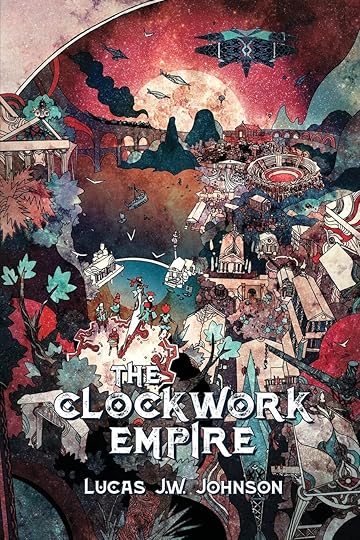
I didn’t mean to write The Clockwork Empire.
Way back in 2012, Fireside Magazine published my short story “Remaker, Remaker.” This was back in the days just before they started publishing Chuck’s The Forever Endeavor serial, when they were really first getting off the ground; “Remaker” was part of their very first public call for submissions.
Through subsequent Kickstarters, Fireside went on to publish two more stories of mine, all set in the same vaguely-realized world: an alternate-history steampunk industrial revolution in which the Roman Empire had never fallen. Otherwise, they were somewhat disparate stories, though: a remaker’s descent into depravity and ruin; a story of love and anger in a world gone mad; and an action/adventure of an investigator, betrayed as she’s on the brink of uncovering a conspiracy.
They did have some connective thread, though. A corrupt and rotten empire. A conspiracy to bring it to ruin. Vague references to recurring names. So there was always this open space in my mind, that they were connected, part of some larger narrative; there was a potentiality to these stories and where they might go. An… unfinished feeling about them. I just didn’t know what the rest looked like!
But Fireside’s editor, Brian White, had always encouraged me to reach out if I wanted to do more with the world. And so I unknowingly began a journey towards The Clockwork Empire, my first novel, out June 28th.
We all like our lists here at Terribleminds, so here’s FIVE THINGS on the way to a novel!
1. Finishing a Project
OK, weird that the first thing on the way to a novel is FINISHING, so bear with me.
I like finishing things. Or rather, I like having things be finished. There are too many projects out there that I want to do, and if I don’t explicitly endeavour to finish the ones that I start, I will end up working for years and years and having nothing to show for it.
(I should caveat that I don’t think it’s important to finish literally everything you start, whether it’s writing, or reading, or watching, or playing; sometimes something isn’t working, and you can and should abandon those rather than get mired in the belief that you Have to Finish It..)
Those threestories were out in the world, and I was proud of them, but they felt unfinished. I was working on novels and games and other things that felt endless, but this, this was a project that maybe I could finish, and put behind me, and move on to other things. So I set out to do so.
2. Tying Threads Together
If I was going to take these three stories I’d published and do something to finish them, I had to think about what the full, cohesive narrative was. I had this idea for what the storyworld was, I had set up some stuff that vaguely referenced each other, but that was it. But because I wasn’t originally setting out to tell a cohesive long-form story, I hadn’t put a lot of time into making sure they fit perfectly. That was going to have to change, if I wanted something that felt cohesive and consistent at the end of this.
Luckily, I’ve been running long-term tabletop RPG games for most of my life. How does that help? Oftentimes these games start out with some one-off adventures or storylines, as the group figures out their characters, and if we’re enjoying the system and setting, etc. Introductory episodes if you will. Then as things progress, the actions of the players help dictate what’s most interesting or important in the ongoing story—a villain gets away, they spend time investigating a side plot, whatever.
Around that time I’m also (as the game master) starting to think about bigger plot points, and where I might take the campaign. Often, I’ll seed little things into early stories—rumours, some note left behind by the villain, hints there’s more going on—without there necessarily being an actual connection between them, because I don’t yet know where the game is going.
And one of my favourite things to do, then, is sit down with all this material, and figure out how it all connects to bring the campaign to a satisfying climax.
Now, I don’t necessarily condone this as a method for novel writing, or at least, a novel would then require a hefty editing pass to bring the early adventures back in line with the overarching plot. But here I had three short stories with a few dangling threads… I could work with that.
3. Things Happened
The original stories had been published over the course of a few years, and it was a couple years later that I was really thinking about finishing them. You remember those years. The mid-to-late 2010’s. Things Happened in those years. You remember those Things.
And because of those Things, more of this concept of the rotten, corrupt empire began to form in my mind. The rise of a fascist demagogue; unchecked corporate power; foreign interference and conspiracy. (You know, Things.) And the dangling threads started to come together into a more cohesive concept.
I began to imagine how things might go differently. I began to wonder what anyone could do about unchecked corruption and fascism.
4. So, Not So Finished Then, Eh?
As Brian had expressed interest in something more from this world, and Fireside published short stories, I put together three more short stories. A nice parallel to the original three, each from a different POV, which together brought the narratives I had begun to a conclusion. There was a lot of empty space there still, but I thought it a nice way to still imply that there’s more going on behind the scenes while wrapping up the stories I’d started.
I reached out to Brian with those stories, thinking that that would finally be the end of this little project, and I could move on to other things.
And then Brian asked if I wanted to turn them into a novel instead.
So much for moving on, but how could I say no?
What I had, then, was an outline: the first three stories were the foundation for the first act of a novel; I had a bit of a midpoint; and I had two stories that wrapped up the ending. And a lot of empty space to fill.
But I’d done this already. I knew how to take different threads and weave them together, fill out more storyline, to get from point A to B to C.
(And then at some point I realized I needed just one more beat towards the middle, so I added a train heist. Who doesn’t love a train heist?)
And thus, I had a first draft.
5. The Stories I Didn’t Know I Was Telling
Then began the editing process.
The main character in The Clockwork Empire is a young man who’s always had health problems, and who—at the very start of the novel, this isn’t a spoiler—is “remade” with a clockwork-powered heart and lung. “Remaking” was a big part of the steampunk world I’d devised (inspired much by Perdido Street Station), and ends up featuring in the climax as well. There are some metaphors around it too, thus “The Clockwork Empire”.
I’d set out to tell a story of queer found family fighting fascism, but Fireside rightly wanted to bring in a disability expert for a sensitivity edit, given the prevalence of remaking. And that edit made me realize that I was also telling a story about disability—not just that there was disability discourse inherent in this world, but that it was truly at the heart (pun intended) of the narrative.
Ace Tilton Ratcliff helped me see that, helped me understand what it was I was telling, and helped me do it well. I educated myself, I edited out the ableism (the English language has SO MUCH ABLEISM, y’all), and I tried to infuse the story with a true respect for the disability community. (As an example, the novel is full of parallels to real-world events, like the 1926 General Strike; I ended up adding an homage to the 504 Sit-In.)
Naturally, this process radically improved the narrative. And it introduced me to a community that, as a mass-disabling pandemic set in, helped give me a lot of perspective in the last couple years.
OK, I Guess It’s Six Things
And so, at the end of the day, I had a novel. A novel I’d had no intention of writing, but one that represented an opportunity too good to pass up, a story I’d wanted to finish telling, and a better understanding of the world I live in.
As I figured out what this story would look like, I returned again and again to the central question: what can we do about unchecked corruption and fascism? And the answer I hope to offer is this: be kind to one another; learn from other marginalised communities, and work together towards common goals; always fight fascists. There is no one answer, just many steps we have to take together.
Lucas J.W. Johnson is an author, game designer, and founder of Silverstring Media Inc., a narrative game design studio. THE CLOCKWORK EMPIRE is his debut novel, and just released June 28th, 2022.
The Clockwork Empire: Amazon | Barnes & Noble | Indiebound | Apple Books
Visit the author’s site. Follow him on Twitter.
Sometimes Writing Is Finding A Place To Put All Your Rage, Sorrow, And Even Joy

In the last, ohh, six or seven years, I think I’ve done a number of versions of this post — I don’t do it to be redundant, or to try to re-farm the same idea for clicks, because the clicks don’t get me anything. I do it mostly because it keeps happening, because the world grows darker and stranger, and I think, quite honestly, that makes it really hard to Make Stuff. And given that this is my job, and also my joy (and mayhaps it is your joy and/or your job, as well), it feels notable to continue to remind myself how the hell to do this thing in the midst of all this area-of-effect trauma. Because I suspect that anybody with one iota of empathy and a few braincells banging together will likely feel caught in a miasma of anxiety and depression, either bearing the brunt of it and smashing themselves like a soup can in a car crusher, or they’re disassociating so heavily that they feel disconnected from everything that makes them want to write stories or make stuff in the first place.
It’s just hard and weird to make stuff, to write stories, right now.
I mean, it is for me. Maybe it’s not for you. No writer is the same, and some will disassociate themselves right into the writing, and hey, fuck it, whatever works.
But for me it can be tough. And I say that as a very, very privileged person. (Yadda yadda, cisgender straight white dude who has a reasonable successful career in writing, etc. etc.) So I can only imagine what it’s like for the rest of y’all.
So for me, I need to occasionally revisit the work, and more to the point, revisit the reason for the work in order to recharge myself. And I don’t think there’s one reason to urge yourself to write and tell stories, whether that’s in a troubled time or in a time of ease and languor; we all write for a panoply of reasons, some very simple (“I like to do it”) to the complex (“I grew up in an abusive household and as such am almost troublingly sensitive to other people’s moods and behaviors, to the point it helps me put that in fiction and contextualize and control what is essentially complex PTSD”). And multiple reasons can be true at a single time. I write horror because I like it, because I like being scared, I like scaring other people, I enjoy the grotesquerie of it, and also it serves as a most excellent place for me to summon the demons of my anxiety and make them fight (and/or kiss) in a narrative arena of my own design, thank you very much.
I think right now, at this moment in time in troubled history, there’s value too — if, let’s say, you’re having trouble getting yourself to sit in front of the story — in viewing your fiction as a box. It is perhaps a blood-soaked shoebox, or a gilded clockwork box, or a box of keys, a box of teeth, a box of gold, a box of bone, but this box is like a reverse Pandora’s Box. Instead of opening it to let All The Evil out, you’re opening it in order to put stuff inside of it. I think there’s value, at least for me, in viewing my fiction as a receptacle for whatever I’m feeling at the time — both in terms of generic emotions and also specific ones. If I’m angry at something, a story is a place to put that anger. It can be a place to put it, not to be rid of it, but to store it. But it can also be a place to put it in order to explore it, to unpack it, to rewire it. And the same can be true for sorrow, or worry, or joy.
And readers may find what you put there useful in the same, or almost the same, way. They too have things to unpack and unravel and examine. And sometimes they just don’t want to feel alone. The story is a signal to them, an echo they hear that reminds them that they are not the only ones feeling this way. Not to suggest stories are, or need to be, an echo chamber; stories can and certainly should challenge the way we feel, and change the way we think. Storytelling, like all things, can be both. Our work can affirm feelings and they can break feelings and it can do this simultaneously, because stories are not one thing. They are broken mirrors in the author’s funhouse.
Obviously, this is essentially catharsis — it’s not a new idea, the notion that we can use art as a purgative, though here I’m not necessarily suggesting that art be the thing that absolves the feeling or rids us of it, but instead I’m saying that the art can make it useful. Because if you’re like me, a lot of you are sitting around feeling like a Point-Toward-Enemy Landmine ready to pop from the lightest pressure, like a little leaf falling on the wind and landing upon you. Boom.
But maybe all these fucked-up feelings can be of use.
Maybe there’s a place for them.
Maybe they’re decoration.
Maybe they’re tools.
Maybe they’re complex machines, I have no idea. Only you can know that.
As such, maybe right now your writing needs to be a corkboard for all the fucked-up things you’re feeling. That’s okay. If it gets you to the page, then do it. The opposite can be true, obviously: writing can be an escape. And if it is, open that door, that portal, and jump on through and get away from *gestures broadly* all this fucking bullshit.
To echo what I’ve said before, it’s okay if you’re not okay.
Hell, it’s normal if you’re not okay. Normal if you feel abnormal. Feeling broken when things are broken is a natural, understandable, even admirable thing.
And if your writing is a box where you can put all your broken feelings, then do so. It won’t fix the world. It won’t even necessarily make you feel better. But it might feel right, and righteous, and at the very least it’s a place to put all the shards and shattered bits of you for now until you can figure out how to put them all back together later on.
It’s up to you.
Failing all of that, you can always write out of spite.
Spite has never failed me — I have written many words fueled by the churning engine of spite. So much spite! So many targets of spite.
Do whatever gets you to the page.
Open the box.
Put whatever parts of yourself need to go in there.
And find the story that lives in that place.
Be well, frandos.



